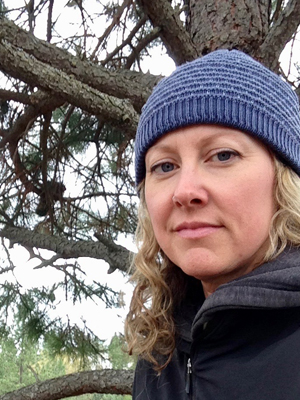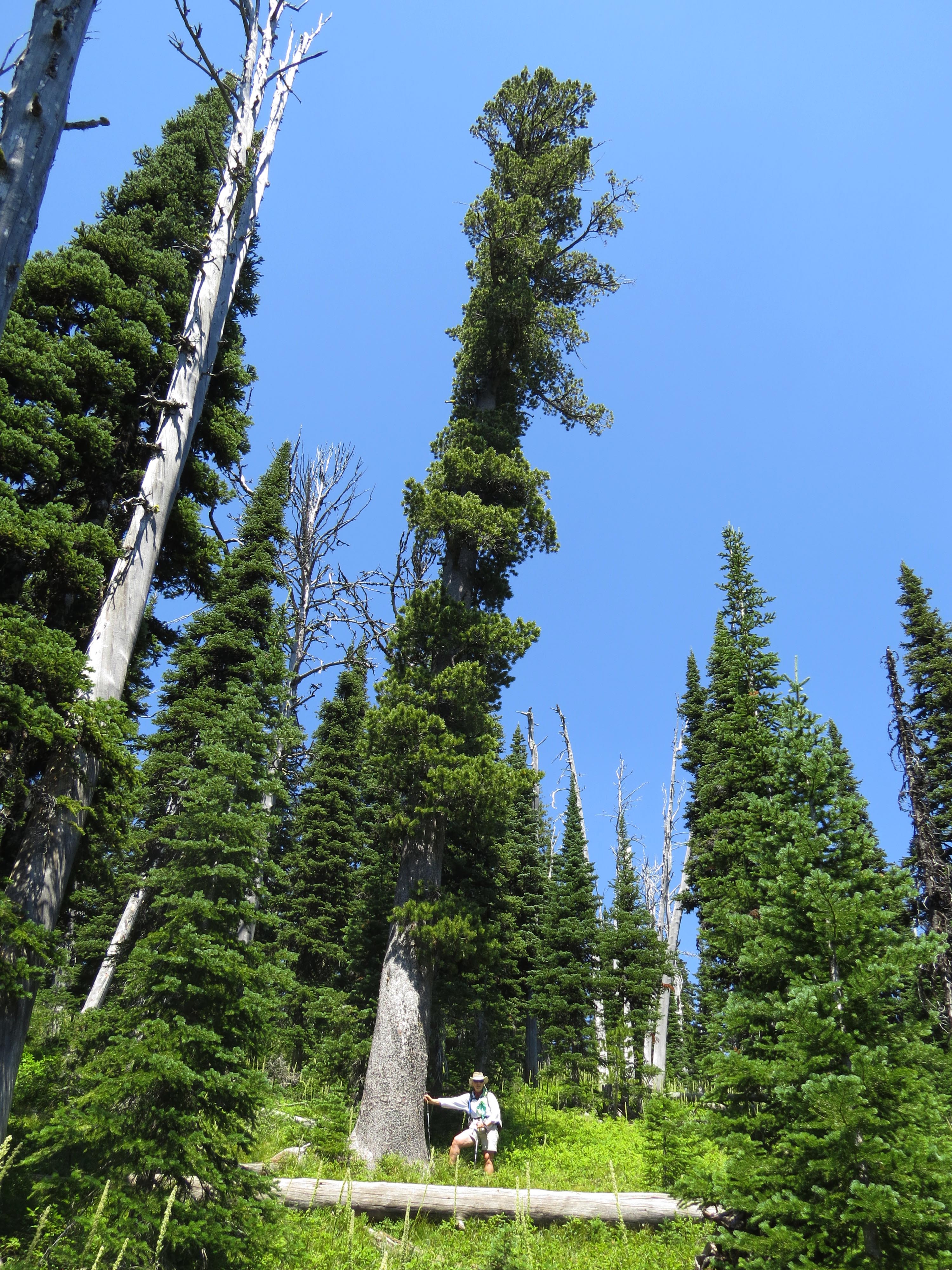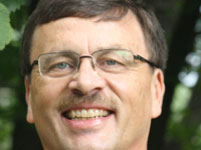
by Dana Johnson
Along the high-elevation, wind-swept ridges of the West, a long-lived, gnarly-branched pine is in trouble. A species of stone pine known for its high stress tolerance and adaptability, whitebark pine is slow-growing and can live between 500 – 1,000 years. Lacking wings for wind-dispersal, its calorie-dense seeds are spread primarily by Clark’s Nutcracker, a member of the crow family with a specialized bill for extracting large seeds from pinecones and a pouch under its tongue for stashing and carrying seeds long distance. Those seeds are a prized food source for a range of species, including the imperiled grizzly bear.
As tough as the species is, whitebark pine is facing mounting pressures from climate change, decades of fire suppression, blister rust, mountain pine beetles, and competing conifers migrating to higher elevations in response to warming temperatures. Already found at high elevations, many worry that whitebark pine will have nowhere to run.
This cocktail of stressors has landed whitebark pine on the short-list for federal listing under the Endangered Species Act. Unfortunately, the proposed listing rule allows logging and other “forest management” activities in whitebark pine habitat, and is, per usual, loudly silent on actions that might address the underlying causes of global warming. Instead, it focuses heavily on intervention and manipulation strategies—like selectively breeding and planting blister rust resistant trees, pruning and thinning stands, fighting back other migrating conifers with logging, applying insecticides and pheromones, and even wrapping pinecones in wire mesh to keep red squirrels and Clark’s nutcrackers from getting at the seeds.
This is a familiar story. Humans are exceedingly bad at exercising restraint and simply not doing things. Rather than drastically reducing consumption, travel, recreation, and development—things that take real personal and political sacrifice but create space for other species to exist—we put an enormous amount of effort into developing technologies that enable us to continue with business as usual or at least provide a veil of plausible deniability regarding our impact on the world. Slap enough windmills on the hilltops, and we’ll never have to slow down. Gather enough data on wildlife, and we can invade their space with abandon. Or, worst case, fire up the helicopters, pluck the critters from their homes, slap tracking collars on their necks, and drop them elsewhere. There is a deep tendency to treat everything as if it is merely an engineering challenge that is solvable with enough data and ingenuity (and money).
This is not to say we shouldn’t pursue things less harmful than our current things—we’ve dug quite an overwhelming hole with climate change, and we need to be creative in how we deal with it. But too often our efforts are tunnel-visioned on maintaining the status quo, and the tougher conversations about how we exist on this planet are altogether muted.
Take for instance grizzly bears. A widely cited research paper states that “[h]umans are the primary agent of death” for grizzlies. We know this. When humans and bears mix, bears end up dead. So, areas with less human access and activity (e.g. recreation, logging, fast-moving cars and trains, etc.) are areas with fewer dead bears. And in areas with greater human activity, we sorely need greater tolerance (and compassion) for bears. As with so many other species reacting to rapidly changing conditions, we need to provide grizzlies with the space to move and adapt, and we need to keep open minds about what that might look like. Yet, in the whitebark pine listing rule, the Fish and Wildlife Service downplays the importance of whitebark pine as a food for grizzlies calling them “opportunistic feeders.” But whitebark pine is often found in remote, high elevation sites away from humans. When whitebark pine seeds are scarce, bears search out other food, which often brings them into lower elevations and in closer contact with humans. We don’t much care for the idea of sharing our favorite creek-side trail with a berry-munching grizzly or dealing with potholes in our golf courses from a bear digging up earthworms, so when an “opportunistic” bear ends up in our space, we trap the bear and move him back to his allotted “recovery zone.” And if the bear crosses our line in the sand again—looking for food, or a mate, or a new home—we kill him, and we go to great pains gathering more data and rationalizing all the reasons why this is the way of things, why we don’t need to change our own behavior or ask, “What gives us the right?”
These tendencies toward control and entitlement make our collective agreement on Wilderness pretty remarkable. Wilderness is a conscious reflection of human restraint—a place where we decided there is value in Nature’s own wild order, in the autonomy and freedom of the wild, and in allowing the land to play whatever hand it is dealt without our intentional interference. It is a recognition that we don’t and can’t know everything and that we might learn something if we step back and observe what happens when we don’t impose our will. Because of this, unsurprisingly, Wilderness is some of the best habitat left for species trying to eke out an existence alongside humans.
The idea of Wilderness as a self-willed landscape has been a difficult one for land management agencies. They have an ingrained history of modifying public lands to achieve “desired conditions,” an idea laden with value bias even in the best of times. Throw climate change and all of its uncertainties into the mix, and the increasing urge to actively maintain static conditions becomes all the more problematic.
Even though the agencies often resist it on the ground, their policy guidance reflects the value in Wilderness. Agency guidance states, “Wilderness areas are living ecosystems in a constant state of evolution[,]” and “[i]t is not the intent of wilderness stewardship to arrest this evolution in an attempt to preserve character existing” at some prior time. And, “A key descriptor of wilderness in the Wilderness Act, untrammeled refers to the freedom of a landscape from the human intent to permanently intervene, alter, control, or manipulate natural conditions or processes.” And, “Maintaining wilderness character requires an attitude of humility and restraint. We preserve wilderness character by … imposing limits on ourselves.” In Wilderness, we “[p]rovide an environment where the forces of natural selection and survival rather than human actions determine which and what numbers of wildlife species will exist.”
Agency policy is taking a notable turn. One agency stated its “policy prior to climate change was to take a ‘hands-off’ approach where overt human influences were not the primary reasons for population fluctuations.” It now believes its role is shifting to adaptive management to maintain “natural conditions,” and this conversation is growing across the agencies. This—at its core—is a conversation about whether we will allow Wilderness to persist into the future.
This shift is reflected in the proposed whitebark pine rule. It lists Wilderness under “Challenges to Restoration,” setting the stage for conflict between an imperiled species and an imperiled landscape. But this is likely a false conflict. Roughly 29 percent of whitebark pine habitat is in Wilderness. Given the variables and unintended consequences inherent in manipulations, that 29 percent should be set aside as an important baseline for comparison to our tinkerings elsewhere. The listing rule acknowledges “a high degree of uncertainty inherent in any predictions of species responses to a variety of climate change scenarios. This is particularly true for whitebark pine given it is very long lived, has a widespread distribution, has complex interactions with other competitor tree species, relies on Clark’s nutcracker for both distribution and regeneration, and has significant threats present from disease, predation, and fire.”
It also acknowledges “[t]here is no known way to control, reduce, or eliminate either mountain pine beetle or white pine blister rust…particularly at the landscape scale needed to effectively conserve this species.” In fact, “the vast scale at which planting rust-resistant trees would need to occur, long timeframes in which restoration efficacy could be assessed, and limited funding and resources, will make it challenging to restore whitebark pine throughout its range. One estimate indicates that if planting continues at its current pace, it would take over 5000 years to cover just 5 percent of the range of whitebark pine[.]”
This does not appear to be a scenario where we have to grapple with fine lines. There is no discrete, human-caused disruption in Wilderness that can be corrected with a discrete, short-lived intervention. This is not an errant patch of spotted knapweed along a stock trail that can be pulled. But it is illustrative of the moral and ethical questions coming our way. Climate change will continue to cause vast changes in the world as we know it, and we will see more attempts to mitigate the effects through ongoing, counterbalancing manipulations. The question will be whether we lose Wilderness in the process.
------------------
Dana Johnson is the staff attorney for Wilderness Watch, a national wilderness conservation organization headquartered in Missoula, MT, www.wildernessswatch.org.

Photo: Keith Hammer

 by Kevin Proescholdt
by Kevin Proescholdt